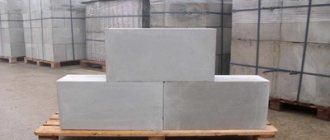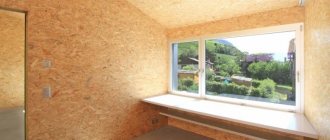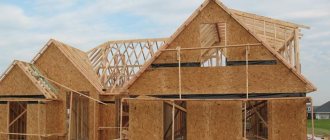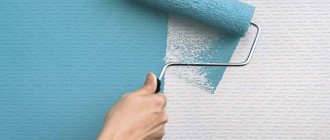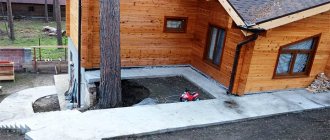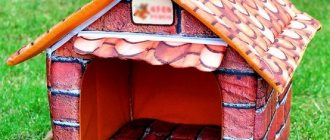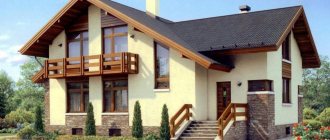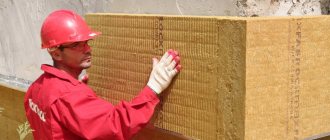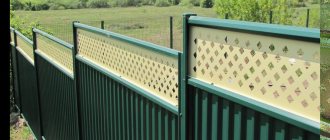Wood as a construction material is experiencing another surge in popularity. The craving for naturalness and natural materials is understandable. But it is not enough to build a wooden house or cottage, you need to provide them with proper care, and in order for the wood to last a long time and not lose its attractiveness, the house needs to be painted. When builders guarantee that a wooden building will last a hundred years, they mean its timely and correct protection from destruction.
Harmoniously selected color when painting a house
Why you need to protect a tree
Professional builders recommend painting a wooden house right away so that it lasts longer. Unprotected wood is negatively affected by almost all environmental factors. If a living tree is covered with bark, then only painting will protect the logs or boards.
- Exposed wood is destroyed by exposure to the sun's rays. Ultraviolet radiation affects lignin, a substance responsible for the lignification of plant cells. As a result, the wood darkens, becomes loose and damp. A fundamental change in the material occurs after six months of being in the open air. Since painting a wooden house over a damaged surface layer will not bring the desired result, you must first sand the surface to an undamaged material.
The logs of the log house dry out and crack over time.
Under the influence of ultraviolet radiation and temperature changes, the boards darkened and cracked
The cracked end of a log - The alternation of rain and dry weather causes the wood to periodically swell and dry out unevenly. The result of the process is cracks of varying depths, which gradually increase. The house becomes unsightly and its ability to retain heat decreases. In addition, mold fungi settle in the cracks and rotting begins.
- Temperature changes in winter lead to moisture entering the pores of the wood during the thaw and then freezing. Ice crystals can tear wood fibers, forming cracks in the depths. Repeated repetition threatens that cracks will spread not only on the surface, but throughout the entire thickness of the frame.
Exterior painting of a wooden house creates a protective layer that serves as a barrier to negative influences.
Criteria for choosing paint for the facade
Making your home more beautiful is probably how many first-time homeowners imagine the goal of painting.
In fact, painting facades achieves two goals:
- protection of walls from the damaging effects of the environment;
- satisfying aesthetic needs.
CMs form a layer of protective film on the surface. No matter how thin the paint layer may seem, the film material, including artificial or natural fillers, resists:
- UV component of sunlight;
- penetration of water into the plaster cover;
- favor of the wall by fungus, lichens, microorganisms;
- surface erosion;
- freezing (preventing the absorption of water, prevents tearing of the plaster in the cold);
- premature aging.
In addition, the colorful film allows the plaster and walls to “breathe”.
Make sure that the paint is recommended by the company for facade work (universal paint is also suitable).
There is no such thing as too much paint, but the thrifty owner is interested in knowing how to choose a paint that best suits the conditions of his home. Painting the facade of a house over plaster is not possible with all paints that are sold, and of those that are suitable, not all give the best result.
It is a mistake to believe that there is a universal coloring agent that is ideal for all operating conditions. Materials with different bases (solvent, modifying additives) differ in physical, chemical, and operational characteristics.
Characteristics important for painting and operation:
- resistance to atmospheric factors (temperature fluctuations, precipitation, etc.);
- resistance to ultraviolet spectrum of sunlight;
- hydrophobicity;
- degree of vapor permeability (affects the possibility of condensation accumulation under the film, as well as the degree of favorable conditions for microorganisms);
- resistance to biological attack by microfauna and microflora;
- rheology and viscosity (affect the possibility of uniform application of the paint layer);
- adhesiveness (characteristic of the adhesion strength of CM to the surface);
- drying speed (taken into account if several layers are applied);
- crack resistance or elasticity (the paint film must withstand the expansion and shrinkage of the plaster coating due to changes in external temperatures), an indicator that is important when painting new buildings that have yet to shrink;
- consumption (the value is directly related to the quality of the base - for rough surfaces the consumption will be higher);
- safety (toxicity, for example, in the case of using an organic solvent, fire hazard);
- content of binders (with a low content, which happens in inexpensive compounds, the service life is reduced);
- service life (determines the duration of the interval between cosmetic repairs);
- price.
In addition, the choice is based on the compliance of the CM with the base on which the paint is applied (type of plaster, material of the walls under the plaster finish). For aerated concrete, the vapor permeability parameter is important. For silicate plasters you need a CM with a silicate binder.
Characteristics important for selection based on decorative indicators:
- glossiness or dullness (glossy compositions look good on plaster with a smooth surface, otherwise they emphasize the slightest scratches);
- hiding power;
- possible palette.
Before purchasing, check the release date stated by the manufacturer (compositions lose some of their working properties over time).
Types of paints
The abundance of modern paints and varnishes provides various options for solving the problem of how to paint the outside of a wooden house. All types of exterior or facade paint are divided into:
- glaze, i.e. translucent, preserving the appearance and texture of wood, having antiseptic properties;
- covering paints are oil, acrylic and alkyd paints that form an additional layer on top of the wood.
Types of paints and their differences in composition
Materials differ in composition, drying speed, appearance and other characteristics. Experts have not come to a clear conclusion about which paint is best to paint the outside of wooden houses, so you need to choose taking into account the wood from which the house is built (dry, damp, treated, old, etc.) and the climatic features of the area.
When choosing high-quality products, the preservation of wood is ensured for up to 15 years. Such a long-lasting and reliable effect can only be achieved by following the rules of painting and preliminary preparation.
Walls
5 votes
+
Vote for!
—
Vote against!
Wooden houses are still popular today. They are environmentally friendly, relatively inexpensive, and thanks to modern protective compounds, they are also durable. It does not matter what type of building materials the building is constructed from - timber, logs or laminated veneer lumber, external facades require protective coating and treatment with antiseptics. This applies not only to new houses, but also to old ones that require renovation. This article will discuss how to properly paint the outside of a wooden house.
Next, we will consider in detail the reasons why it is necessary to restore the paint and varnish coating of a wooden house on the outside, the types of compositions that are suitable for external work on wood, and the technology for painting the outside of a wooden house with your own hands.
Causes of wood aging
Wood is a material with a living structure. Even a growing tree ages and becomes rotten over time, but in a felled tree these processes occur much faster. Untreated material loses its original luster in just one season, becoming gray. Therefore, to maintain an aesthetic appearance and to protect the wood itself, such houses require regular treatment.
- Atmospheric influence . This is sun, rain and temperature changes. They make the structure of the wooden facade rougher, reducing elasticity and changing its color from yellow to gray. Due to frequent expansion and contraction with changes in humidity, cracks appear, aggravating the aging process.
- Rotting and mold . They appear in places where the greatest amount of moisture accumulates - in cracks, over time, spreading to the entire surface. Mold is easy to notice even in the initial stages, since most often it is a different formation of gray-blue color, sometimes black. These stains do not greatly affect the quality of the wood structure, but are harmful to health. But the further decay caused by them is already dangerous and requires immediate intervention in the form of painting with special compounds.
- Bark beetles . They can even appear in new houses if the wane was not properly removed during construction or if low-quality material was used (for example, for roof sheathing). They can spoil wood unnoticed for many years. It is very difficult to get rid of them.
Advice: it is especially important to take care of high-quality protection of the facade of a wooden house if it is located near a large body of water or near highways with heavy traffic.
Choosing a paint color for your home's exterior
This is an important question, because the chosen color will affect the mood and satisfaction from the work done. The most convenient way to do this is directly in the store, where samples of wood painted in different shades are presented. When ordering paint online, the monitor may distort the actual color.
Looking through the options for painting wooden buildings in a magazine, a feeling of delight often arises, however, when choosing a color for their home, most people reach a dead end, not knowing what exactly to choose. A few tips will help here:
- First, you should decide whether the entire house will be repainted or just its individual elements. In the latter case, the color of the dye should be in harmony with the existing tone;
- some cottage communities require that the houses be similar in appearance, which means that the coloring must match the neighboring houses;
- the color of the composition applied to the wood may differ greatly in the artificial lighting of the store and in street light. Therefore, many consultants recommend purchasing a small jar of dye (often, upon request, I can tint a very small volume especially for the customer) and paint some element on the facade. This will allow you to accurately decide on the option.
When choosing a shade for your home, you need to take into account the surrounding environment. For example, in a pine forest, houses with warm shades of wood facades look beautiful, and for a light birch grove it is better to choose gray tones in the Scandinavian style.
The main thing worth remembering from the basic rules is that light shades, and especially white, visually increase the size of a wooden cottage, but dark colors, on the contrary, reduce it.
Choosing paint for painting a house
Despite the fact that the modern construction market is filled with all kinds of paint and varnish products for wood, the choice of its characteristics is quite poor. Despite the fact that some formulations are widely advertised, while others are practically unknown, their components are similar. Over the past decades, no fundamentally new coloring compositions have appeared; for example, the classic oil paint of the famous Tikkurila brand has been produced without significant changes for more than 70 years. This suggests that despite the promising advertising of new dyes about unprecedented longevity, they should not be taken at face value.
- Oil paints for wood . Most often, this is a more budget-friendly option for painting the wooden facade of a house. Their main advantage is that they are able to penetrate quite deeply into the wood structure, making it resistant to the negative influence of atmospheric conditions. But in order for the house to always look aesthetically pleasing, this coating requires updating every 5 years or more often, depending on the conditions of the region. Another drawback is low resistance to ultraviolet radiation. This means that the south side of the building will lose color saturation faster (of course, this only applies to bright shades). Drying oil-based compositions take quite a long time to dry. Even in sunny and warm weather this takes several hours. Therefore, to prevent dust from sticking to the new facades, you need to choose calm weather for work.
- Acrylate paints for wood. This is the best dye option for the wooden facade of a house. This is primarily due to their ability to create a reliable vapor-permeable coating. That is, after application, a layer is formed that can breathe, just like wood. In addition, even after hardening, alkyd paints remain flexible enough to not crack when the wood dries out seasonally. All this allows you to extend the performance characteristics up to 8-10 years without the need for new repairs.
- Covering antiseptic for wood . They are based on an acrylate-alkyd composition. This is a relatively recently introduced type of product, but with a number of advantages due to which it is gaining popularity. This composition can give cheap wood the appearance of an expensive material. This allows you to save money during construction when you want to achieve a respectable result inexpensively. In addition, such antiseptics retain their appearance for more than 10 years without tinting.
- Varnishes, stains, azures . If expensive materials were chosen for the construction of a wooden house, then you should opt for a colorless and durable coating. They will add gloss to the surface, without distorting the color, but only slightly change the shade and fully show the beautiful texture of the natural material. If desired, they can be tinted, in which case the color saturation will depend on the number of layers applied.
When asking the question of what is the best way to paint a house, most rely on the price/quality ratio. So you can make a rough overview of the most famous manufacturers:
- Budget paints. These include economy options, the cost of which does not exceed 100-150 rubles/kg. These are “Senezh”, “Aquatex”, “Texturol”.
- Average price category . Their price ranges from 250-350 rubles/kg. The most famous are Tikkurila and Belinka.
- Premium paint – from 400 rub/kg and above. These are foreign and "Johnestones".
Useful tips for painting a wooden house
- If a new house is being painted, the choice of paint is unlimited and depends only on the preferences of the owner. It’s a different matter if repair work is being carried out on a previously painted wooden facade. In this case, it must be painted with the same composition that was applied before. But there is a small nuance: if the wall was painted with oil paint, then acrylic paint can be applied to it after preliminary treatment.
- If the work was previously carried out by other owners, then first you need to determine the type of paint. Using a sharp stationery knife, cut off a piece of the composition or make an incision and look: if it breaks and crumbles easily, then it is oil paint, if it has enough elasticity to roll into a roll, then it is acrylate paint.
- It is better to paint on a cloudy day, when there is no bright sun, but no rain is expected. This is due to the fact that when direct sunlight hits a freshly painted wooden facade, the paint may dry unevenly, forming streaks.
- You should beware of purchasing products that have appeared on the construction market only recently. Even if the manufacturer indicates a warranty period of up to 15-20 years, it has not yet been possible to verify this in practice. But in any case, the manufacturer indicates it taking into account the fact that the wood has been previously treated with antiseptics and preparations and primed. Without this, the service life is sharply reduced.
- When purchasing, it is also important to pay attention to coverage characteristics. That is, the consumption of the composition per m2, so often a jar with a smaller volume can cover a larger area than a cheaper analogue. This means that it is not always worth focusing on the price parameter “rub/l.”
Painting wooden houses. Preparatory work
- Before you start painting the outside of a wooden house, you need to carry out preliminary preparation of the walls. For a new home, they consist of applying an antiseptic and primer. But when renovating an old building, there will be significantly more work: sanding to good wood and processing cracks. These procedures will protect against possible unevenness or peeling of the old and new paint from each other.
- The problem with most wooden houses is their seasonal "movement", leading to cracking of the paint if it does not have sufficient elasticity. Moisture easily penetrates into the cracks that form, which leads to further destruction of the paintwork and the wood itself. In addition, mold that forms in such places has a detrimental effect on human health, causing pulmonary diseases. The only exception is houses made of laminated veneer lumber; thanks to the production technology, they do not form cracks and painting is needed only for aesthetic purposes.
- Therefore, first, with a metal spatula, all exfoliated areas and those that can be easily cleaned are roughly removed. After this, using a grinder with a special disk, clean the surface to light and clean wood. This guarantees the durability of the repair.
- The easiest and cheapest way to treat mold cracks is with a spray bottle of regular white, which is sold at any hardware store. The concentration is taken at 100%, that is, without dilution with water. Due to the pungent odor, even outdoor work must be carried out in a respirator, safety glasses and gloves.
How to properly paint the outside of an old wooden house
- Sometimes, after complete sanding, the surface of the wood has many nicks and irregularities. It is advisable to smooth them with coarse sandpaper. Again, these cleaning discs are sold for grinders, which greatly speeds up and simplifies the process. As a result, it turns out to achieve a fairly smooth surface.
- The next step is to apply the primer. Today, you can find special primer compositions for wood on sale that already have antiseptic additives. Thus, the work is cut in half. Doing this with a brush takes a very long time; it is much more convenient to use a spray gun. In order not to buy it for a one-time job, you can rent it. It is recommended to apply it in two layers.
Tip: for a more saturated color as a result of painting, add the required amount of color to the primer so that it is as close in color as possible to the paint itself. So, if the house is painted gray, then the primer should be gray. It is best to do this in the store where the composition was purchased.
- Painting begins only if the wood is completely dry. After opening a new jar, mix the composition thoroughly for a couple of minutes until it becomes homogeneous. For work, choose a wide brush with fine bristles. It is best to buy a varnish brush; it will allow you to apply the paint more evenly. Work begins from top to bottom, carefully ensuring that no leaks form. The strokes are made horizontally, along the grain of the wood.
- When working with a spray gun, the same requirements are followed. But with it, the paint goes on more evenly, and the consumption is reduced.
- As a rule, applying one layer cannot avoid noticeable smudges, and the coating itself is not strong enough. For exterior work, in addition to the primer layer, it is recommended to apply at least three layers of paint.
How to properly paint a wooden house outside video
Wood pre-treatment
In order for the paint to apply smoothly, absorb well and last a long time, you need to prepare the surface for painting. Before treating the outside of a wooden house with any compound, antiseptic or fireproof, it is necessary to level the surface and seal the cracks.
After finishing the construction of the house, it is necessary to seal the joints and putty the cracks
The main condition is that the wood must be dry with a moisture level of no more than 20%, so preparation begins in the dry and warm season. If you put paint on a wet surface, the internal moisture will evaporate and destroy the coating and tear it away from the base.
The dry surface is cleaned of dust and dirt. If stains and stains of resin are difficult to remove, you can use a solvent. It is advisable to sand wood that was previously exposed to the open air mechanically.
Additionally, read the article “How to choose a wood sander.”
After sanding, painting is carried out within 48 hours to ensure that the maximum effect of sanding is preserved.
First, the surface is treated with antiseptic primers or wood impregnations. Sometimes builders take on this work, but they often use the cheapest compounds - not very effective for preserving wood and environmentally unsafe. It is recommended to use water-based antiseptics that protect against the formation of mold, mildew and other biological formations on wood.
Antiseptics for wood
The application of antiseptics is carried out in strict accordance with the instructions indicated on the packaging. You cannot process at subzero temperatures, even if manufacturers offer winter antiseptics.
The better to paint
Paint for the facade of a wooden house can be translucent, glossy or matte. Since the natural look of wood is most attractive, glazing facade materials, which are available in the form of antiseptics, glazes or oils, are very popular.
The peculiarity of these materials is that they do not hide the structure of the wood. The materials work as impregnations, penetrate deep and create a barrier to getting wet or exposed to ultraviolet rays (UV). Despite their transparency, glaze paints are available in a wide range of colors. The most famous manufacturers:
- Renocoll (Rhenocoll) Germany.
- Teknos Finland.
If there is a desire to hide the surface of the wood, then use façade covering paints, which are divided into:
- oil - made from oils of natural origin and organic solvents;
- alkyd - produced in organic solvents or aqueous solutions of alkyds;
- acrylate (acrylic) coatings - based on acrylic and copolymers (latex, vinyl, silicone).
These paints form an opaque protective film that completely hides the wood grain. Over time, they oxidize, cease to be elastic and crack. Subsequently, the top layer turns into a powdery white substance (paint chalking process). After a few years, the layer will need to be removed completely or partially and the work done again.
Acrylic paints are more expensive and have a high degree of elasticity.
Well-known manufacturers of covering paints:
- Tikkurila (Finland).
- Alpina (Germany).
- Dufa (Germany).
- Beckers (Sweden).
- Dulux (Netherlands).
- Marshall (Türkiye).
Facade acrylic paint Dulux
Tikkurila paints are well known among us
Impregnation for the protection of wooden surfaces from Dufa
Among the Russian brands, the most popular are “Optimist”, “Svyatozar”, “Tex”, “Yaroslavskie Krasny”.
Average paint service life:
- glazing antiseptics – 5 years;
- acrylic – 8–10 years;
- oil – up to 6 years;
- alkyd materials – 7 years.
When comparing different types of paint, consider their pros and cons:
- oil paints – have a high penetrating ability, reliably protect against moisture, but dry slowly (several days depending on the temperature), which is sometimes unacceptable for outdoor work;
- alkyd compositions - have good frost resistance, but crack over time under the influence of UV;
- acrylic - convenient and easy to use, odorless, do not lose color, a new shade is easily obtained by mixing white paint with colorants (colored dyes), but if the house is painted with acrylic paint, then in the future you can only use them.
In recent years, acrylic paints and varnishes have taken a leading place, despite their higher price. Considering how much it costs to paint a wooden house and the effort it requires, it is not advisable to focus on cheap types. It’s better to do it well once than in 2-3 years the house will look sloppy. Immediately choose how to paint the outside of a private house or cottage for a long time , even if you have to invest more.
The total cost of painting depends mainly on the size of the house. This amount will include the cost of antiseptic, putty and paint.
How to choose façade paint for a specific surface?
- First of all, to correctly select the outer covering, you should take into account the base material . Most façade coatings specialize in concrete (including after wall insulation with foam plastic), brick, aerated concrete and plasters of various compositions. At the same time, water-based paints are not always suitable for wooden surfaces and are completely unsuitable for application to metal (steel) substrates, which is the main difference from paints based on organic solvents, which serve as reliable protection for such substrates.
- The second selection factor is surface quality . The presence of shine and the color of the walls directly depend on the composition of the paint used for exterior decoration. Water-based mixtures have lighter tones and a predominantly matte surface, while organic-based materials make it possible to obtain coatings with a hard shine in dense tones, and the choice of color and its tonality is much wider than that of water-based paints.
- At the same time, we must not forget about the operating conditions of the building - in areas with high levels of atmospheric pollution from various industrial or other substances, dust or the presence of large amounts of exhaust gases (industrial or close to large highways), paints with high water-repellent ability should be used , allowing you to safely endure periodic cleaning the walls. For regions with frequent rains, this choice is also relevant, since the penetration of rainwater into the wall material threatens their destruction.
Which color to choose
The choice of color depends only on the wishes of the homeowner. Manufacturers offer a wide range of shades. Typically, preferences depend on the design of the house and the location where it is located. To make the house visually blend with its environment, various shades of green, sand, and brown are chosen.
There are no restrictions on the choice of color, the main thing is aesthetics
To highlight a building in the area, you can use bright white, blue, and yellow. The most effective is the combination of two colors - light and dark.
A significant part of developers are more focused on the practical effect of painting, for example, dark colors attract rays, the surface heats up too much and cracks form on the wood. Light shades reflect light and do not fade longer, but dirt is more visible on them. The light gray color fades the least.
If resin appears on the wood, they prefer light dyes so that the wood does not heat up. Resin secretions are less noticeable against a background of cream, white, or ivory.
Often, paint is chosen to match or contrast with the color of the roofing material.
Additionally, we recommend the article “Mixing colors to get the right color.”
Painting a brick house
Brick houses are distinguished by their fundamental nature and durability. Most often, brickwork is used to create a decorative appearance for the building. If there is a need to paint a brick wall, then the choice should be guided by personal preferences and structural features.
For brickwork it is not necessary to use natural shades, as, for example, for wood. You can choose any colors, but remember that light colors are most suitable for large and simple modern structures.
The style of the building determines the color: in the Baroque style, it is preferable to paint brick buildings in brown and terracotta colors, for Gothic - gray and dark shades . It is recommended to use light colors to design openings and protruding elements.
Sequence of painting work
To properly paint a wooden house, you need to follow the technology and sequence of actions. Painting a frame house follows the same rules as a log house.
- First of all, the surface is cleaned of dust, construction debris, and resin stains - otherwise, mixed with the paint, foreign particles will remain on the facade. If this is not the first treatment of the building, then carefully remove the previous paint and clean the surface down to wood.
- Then mechanical grinding of the surface is carried out manually or using a grinding machine. Sanding and further painting are carried out with a short break, no more than 3 days, so that the cleaned base does not have time to suffer from external factors.
- In an old house, cracks, unevenness and damaged areas are puttied. If nails or other metal elements protrude from wood, they are coated with a special primer designed for metal.
- After this, the entire surface is covered with a primer with antiseptic properties and impregnations. The primer will not only perform protective functions - after its application, paint consumption will noticeably decrease and it will apply more evenly.
- Then they move directly to painting. The paint is applied with a roller or sprayed with a spray gun. It is necessary to take into account that acrylic facade paints and varnishes are too thick and viscous - only a professional tool is suitable for them. To use household sprayers, the paint will have to be thinned, which means the layer will be thinner than the manufacturers recommend.
- Painting is done in several layers. Each subsequent layer is applied only after the previous one has completely dried. When painting with a roller or brush, apply the paint along the grain of the wood.


